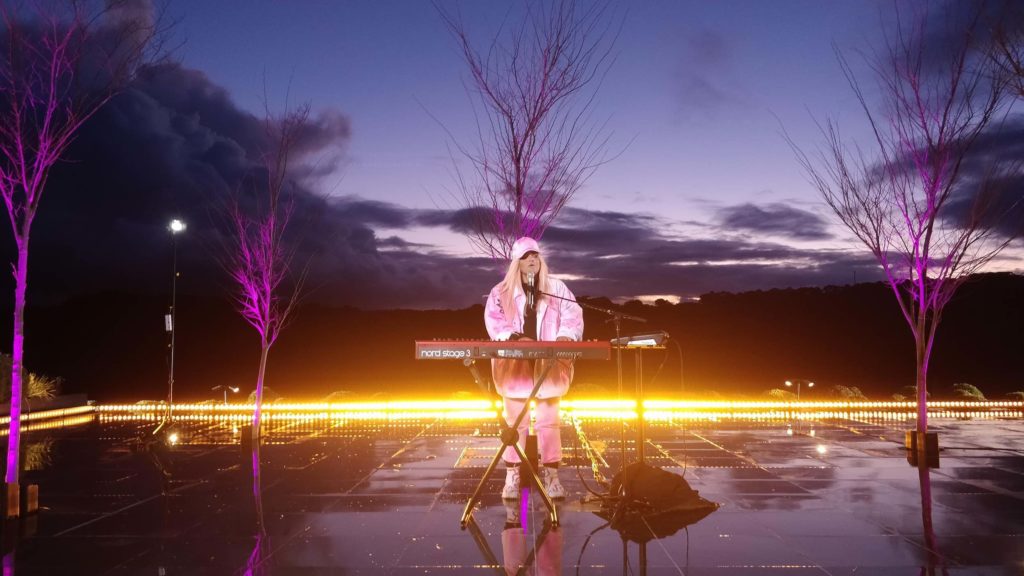Subscribe to CX E-News
Lynden Gare and Colourblind go back to their roots
When Melbourne’s creative lighting design agency Colourblind were forced into lockdown harder and longer than most, Director Lynden Gare and the team drew on their history in broadcast to help their clients continue to deliver to their audiences…
“One of the first livestreamed events we were heavily involved in was the Isol-Aid Festival,” begins Lynden Gare. “It was 20 minute musical performances, streamed on Instagram live from 10 pm to midnight, all in support of the artists.
“We worked on the festival in April and May. We’d do three acts on Saturday night live to camera, with one camera locked off.
“Our general manager Claire Casement and I both worked at Channel 9 in our early 20s. We were both trained to light for camera; what’s involved, how to approach composition, and what works, which became really useful for streaming work, and knowledge that we could pass on to the rest of the Colourblind team.”
With Colourblind’s reputation well-known in EDM and touring circles, what’s not as widely publicised is their extensive experience in broadcast.
“All light creates an emotion,” observes Lynden. “Everything from position to colour matters to a camera. The big difference between live and broadcast is that in broadcast you’re lighting for one angle.
“If we’re working with one keylight, then we could position it on the off-camera side of someone’s face to make mood with shape and shadow. If we’re lighting a lighthearted, poppy band, we might go with a big soft source. We have to think about how lighting effects the emotion of the song.
“In broadcast and streaming, we’re not relying on the colour and movement of moving lights to convey what’s in the music. We’re usually focussing on what someone’s face looks like. On camera, sometimes that’s the only thing we’re looking at.”
The tools and workflow of getting a good look on camera is quite different to a big arena show.
“We almost don’t use our eye at all,” Lynden says “We balance while looking through a monitor. You’ve got to be careful not to use overly saturated colours. Something might look one way to the eye, for example a beautiful rich saturated magenta, and through the camera it might look blobby and pink.
“There’s almost no point in looking up from the lens when you’re making sure everything looks as intended.”
The biggest difference between the live and broadcast workflow is the pace of structure of the work. “Broadcast and streaming are finely tuned things,” relates Lynden.
“You have to finesse a look for a few minutes, get the shot, and be done. It’s meticulous. It’s not actually a slower pace than live – sometimes you have to do things very quickly. It is however more refined.
“You achieve fewer looks in a day, but might only have a few minutes to create each of them.”
With ‘streaming’ meaning everything from a solo muso in their lounge room through an iPhone, to a professional multicamera studio shoot with a massive lighting rig, the Colourblind team have worked every variation through the pandemic.
“Something streamed live might be a quick rehearsal to make sure the colour palette is nice on people’s faces and away you go, or so much more,” says Lynden.
“We did one livestream music event where we went all out. Matt Downes at South West Solutions set up a huge lighting rig in his warehouse.
“Showtech Australia delivered a special slow geared winch, and over the course of a 30 minute performance, we produced a light and laser show around a riser that moved 3 cm a minute down the room.
“At the other end of the scale, we’ve done streams with a soft keylight
and backlight with no control and a single camera.”
Like many production companies, Colourblind has capitalised on the ability of SRT and cloud hosting to deliver on jobs in other states and even countries.
“We’ve been working with Tones and I, who has had lot of guest spots on overseas breakfast shows,” illustrates Lynden. “We provided her with a simple rig, delivered to her house.
“Her housemate sets it up when required, and we operate it remotely. We provide the link between her house and the television station overseas. We remote desktop to the laptop we’ve sent, and do a quick mix of her keyboard and vocal remotely via SRT.
“We’re using software called Restream, and we sometimes use OBS hosted in the cloud via Telstra.”
Meanwhile in Iso – Freakin’ Lasers!
Like many, Colourblind have taken the opportunity inherent in enforced downtime to do a bit of upskilling.
“At the last LDI in Vegas, I met a lady that runs a company that specialises in laser safety training,” shares Lynden. “I hadn’t found anyone in Australia that did this, so I got her contact details.
“In April, we put the feelers out to freelancers and our partners around Australia and asked if anyone was interested in doing the training with us.
“It was $300 a head, and ran five hours. In the end, we got 20 people in total trained up in the safe operation of lasers for entertainment. It was a mix of LDs, production managers, and stage managers, all of whom now have a better appreciation of the possibilities and hazards of lasers.
“I would now never, ever point a laser into a crowd, or a camera for that matter, not that I’ve ever done that before, of course! Seeing the damage that can be done is very sobering. I don’t ever want to be the person to make the decision to point a laser at a crowd. All it would take is for a mirror to fail and a beam to be static for a second.
“Drug and alcohol consumption, obviously common at festivals, slow down eyelid reactions, so there are many things to consider when pointing beams into an audience.
“After this training course, I think the whole industry can reduce risk based on safe work methods.”
Mental Health First Aid
Crew charity CrewCare has partnered with Support Act and Griffith University to arrange for accredited courses in Mental Health First Aid training for CrewCare members, approved by the national Mental Health First Aid body and facilitated by Paige Gaudry from PNP Health.
All any company has to do to access the course is become a CrewCare member. Colourblind, along with other companies around Australia, have taken them up on the offer.
“As creative people, we are so exposed to common triggers for anxiety and depression,” remarks Lynden. “We can be on tour away from family and friends, with easy access to drugs and alcohol, and under lots of pressure to perform. We’re always showing the vulnerable side of ourselves, whether tech or performer. Add sleep deprivation to the mix and it’s a potent cocktail of risk.”
The course equips crew with the tools to identify the signs of someone struggling, and how to get them the help they need.
“The course is not for people who need help themselves immediately,” clarifies Lynden. “This is for those of us in supporting roles. Mental Health First Aid equips crew with the ability to help people to get help. It’s not turning us into counsellors; it’s the first step to helping others.
“Anyone who feels like they are often a confidant or counsellor to their to crew, and who likes helping people, should do this course. If several hundred Australian crew from all corners of the industry do this course, and we’re getting close to those numbers, it will put the industry in a good position coming out of COVID.
“I can’t recommend it highly enough.”
More information: crewcare.org.au/mhfa-training
Colourblind
colourblind.com.au
CX Magazine – December 2020
LIGHTING | AUDIO | VIDEO | STAGING | INTEGRATION
Entertainment technology news and issues for Australia and New Zealand
– in print and free online www.cxnetwork.com.au
© VCS Creative Publishing
Subscribe
Published monthly since 1991, our famous AV industry magazine is free for download or pay for print. Subscribers also receive CX News, our free weekly email with the latest industry news and jobs.



















